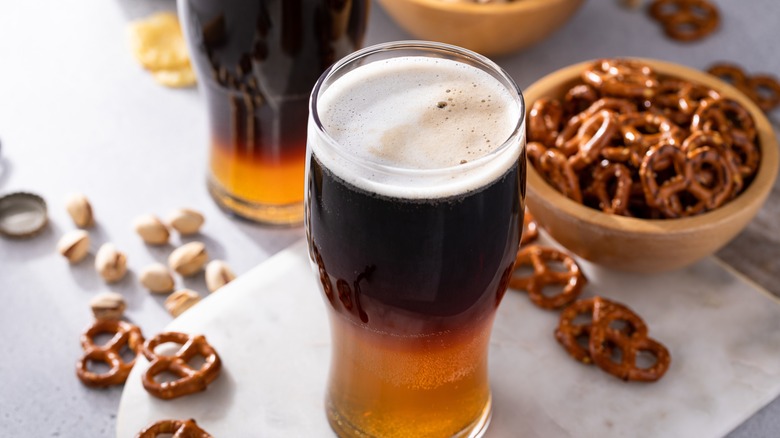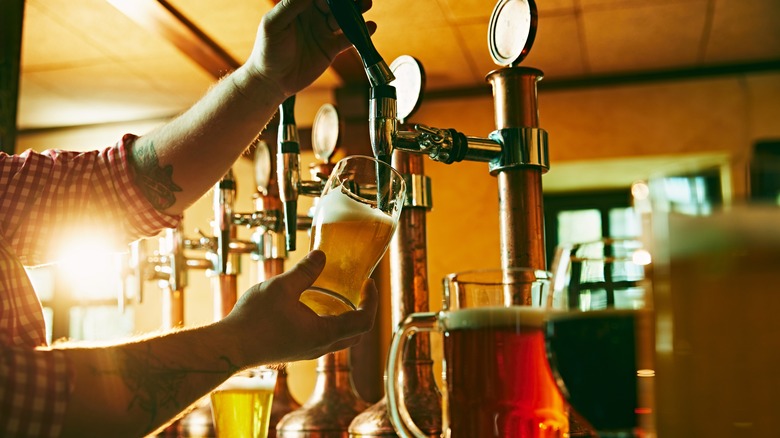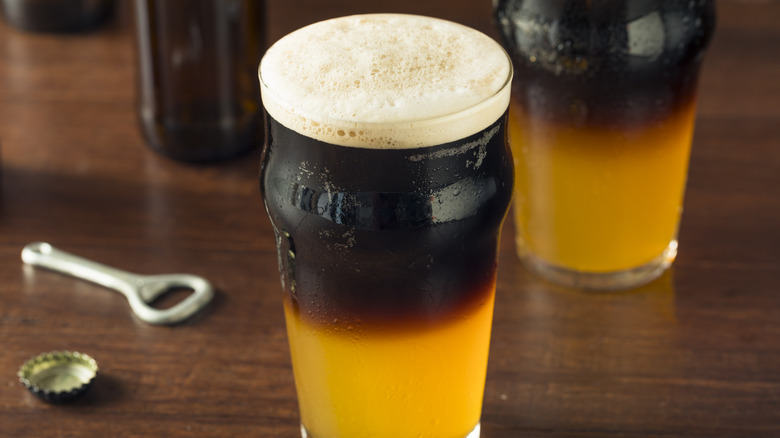How To Pour The Perfect Black And Tan Beer Cocktail
The black and tan is a beer cocktail with a complex flavor profile, perfect for beer lovers looking for something more exciting than an ordinary bottled brew. This combination of Guinness stout and Bass Pale Ale is not only impressive-looking, it also has a delicious depth. The two classic U.K. brews mix with each sip into a surprisingly well-balanced and refreshing beverage.
The true magic of a black and tan is in its presentation, however. When poured correctly, the Guinness floats effortlessly on top of the Bass Pale Ale, similar to other suspension cocktails like the classic tequila sunrise. Though anyone who's had a Guinness might guess this hearty beer is dense enough to sink to the bottom of the glass, the opposite is actually true. Guinness is actually lighter than Bass Pale Ale, likely because the classic Irish stout contains less sugar than the ale. This also accounts for Guinness' bitterness versus Bass Ale's slightly sweet undertones.
Guinness and Bass, being opposite in both density and flavor, make the black and tan visually stunning and interesting to drink. The first few sips may consist mostly of Guinness, but as you tilt the glass and the beers become parallel to each other, the Bass ale will slip through to balance out the stout's dark bitterness. Similarly, Guinness will help deepen the ale's flavor and aroma, giving it an almost nutty scent and taste that pairs exceptionally well with dishes like fried mushrooms or corned beef.
How to pour the perfect black and tan
Making black and tans correctly often takes some practice. Despite the fact that Guinness is lighter than Bass, the two beers will likely mix if you simply pour one over the other. Proper technique and plenty of patience are the keys to taking advantage of the beers' contrasting densities and pouring the perfect beer cocktail.
The first trick to layering a black and tan lies in how you pour the ale. Typically, people pour beer from bottle to glass slowly and along the inside of the glass to prevent a tall head. Since a tall head helps black and tans layer more easily, you can simply turn the Bass Ale upside-down and let it glug into your pint glass. This pouring technique will result in a robust, creamy layer of foam for the stout to float on.
Pouring the Guinness is where you'll need to exercise patience. First, you'll need a spoon. A regular spoon will do, but you can also invest in a special black and tan spoon, which has a narrow bend in the handle to keep it balanced on the edge of the glass. They're incredibly handy, but not essential, as you can simply hold a regular spoon convex-side-up over the center of the glass. Next, slowly pour the Guinness over the back of the spoon. This technique helps distribute the stout gently over the ale to prevent them from mixing. Practice until you get a feel for the technique.
Delicious black and tan variations
Guinness stout and Bass Pale Ale are the traditional black and tan ingredients because they have the perfect densities to remain separate in the glass. However, don't let that stop you from experimenting with different combinations at home. The best combinations will likely be a dark porter or stout on top of a pale ale, as pale ales tend to be heavier than the darker beers.
For instance, if you prefer Left Hand Milk Stout, you can experiment with layering it over a pale ale or cider, such as Blue Moon or Angry Orchard. In fact, there are a handful of standard variations on a black and tan that you can use as a template — Guinness combined with a pumpkin ale or hard apple cider, for example, is called a black and orange or black and gold, respectively. Feel free to try replacing Guinness in either of these drinks with your favorite coffee or chocolate-forward stout.
Chocolate stouts are also delicious layered on top of lambic, Belgian-style fruit beers. The most common combination is chocolate stout floated on raspberry lambic to make a black and red. However, cherry or blackcurrant lambics also have an aromatic fruitiness that pairs beautifully with dark, bitter stout. If you're not sure what meal to pair with your beer, focus on deep flavors and rich fats that stand up to the beers' pleasant bitterness.


